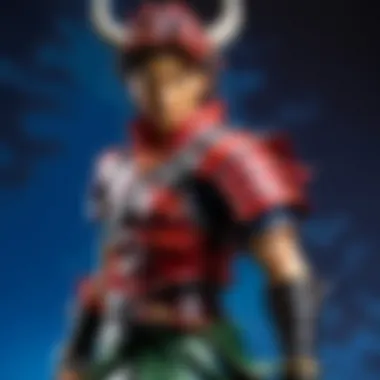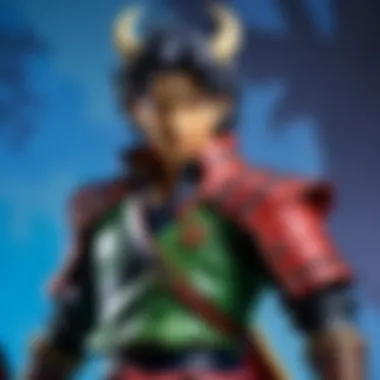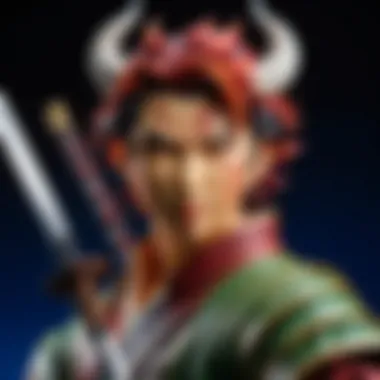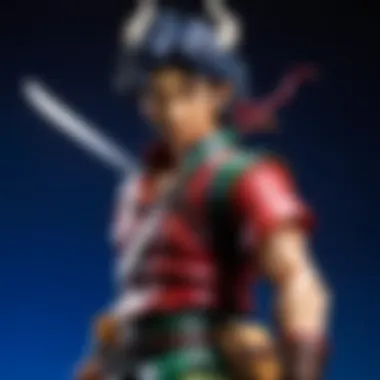Demon Slayer Part 2: Themes, Characters, and Culture


Intro
Demon Slayer Part 2 reaffirms its position in the realm of anime, balancing intricate character development with a gripping narrative. In this compelling continuation, themes of resilience, sacrifice, and brotherhood sharpen the viewer's experience. At the same time, the cultural implications grow, influencing not just anime fans but also the broader landscape of pop culture. This article explores various aspects of the series while providing insights into figures, merchandise, and the evolving trends within the anime industry.
Featured Figures and Merchandise
Demon Slayer’s immense popularity has sparked the development of a vast array of figures and merchandise, allowing collectors and fans to celebrate their favorite characters. The demand for high-quality collectibles is unique, reflecting the intricate design and artistry of characters like Tanjiro Kamado and Nezuko Kamado.
New Releases
Recent months have seen exciting new releases of Japanese plastic figures from various manufacturers. For instance, Bandai has launched a collection featuring Tanjiro in his iconic water-breathing stance. Another noteworthy release includes a detailed figure of Zenitsu Agatsuma showcasing his electrifying movements. Collectors find these figures not just as mere toys but as a way to connect with the narrative and emotion of the series.
Limited Editions
Limited edition collectibles often cause excitement within the fanbase. Figures that are part of exclusive runs, such as those from Good Smile Company, are often highly sought after. These unique pieces typically feature enhanced paint applications and special packaging. The limited availability adds value and intrigue, making them ideal for dedicated collectors.
Must-Have Items
Among the must-have merchandise, the premium quality figures of Kanao Tsuyuri and Inosuke Hashibira stand out. These pieces have gained popularity due to their detail and articulation, allowing for dynamic poses. Fans continuously engage in discussions about upcoming figures and which scenarios they hope to see represented in future merchandise releases.
Figure Reviews and Analysis
In the realm of collectibles, critical analysis can greatly enhance buying decisions. Evaluating figures requires understanding their design, materials, and overall appeal.
Detailed Reviews
Take, for example, the Nendoroid figures of Tanjiro and Nezuko. They feature interchangeable facial expressions and accessories, allowing for various display options. These figures balance quality and playability, showcasing craftsmanship that resonates with both collectors and casual fans.
Comparative Analysis
Comparing figures, such as those by Bandai and Good Smile Company, reveals notable differences in quality and aesthetic choices. Bandai tends to offer more dynamic poses in their accessories, while Good Smile focuses on realistic representations of characters. Fans should consider what aligns more with their preferences before making a purchase.
Tech Specs and Materials
Most figures are crafted from PVC, offering durability while allowing for detailed designs. It's essential to examine the tech specs, including height and articulation points. A standard high-quality figure ranges around 6 to 10 inches tall, ensuring they fit well in most display setups.
Anime Merchandise Trends
The evolving landscape of anime merchandise is noteworthy. It's essential to stay updated on emerging trends that affect collectors and fans.
Industry Insights
The anime merchandise industry is thriving, driven by ongoing series and the introduction of new characters. The rise of digital marketing tools has also enabled manufacturers to reach broader audiences, translating into increased sales of figures and collectibles.
Collector's Corner
Avid collectors often have unique stories about their experiences. Many frequent platforms like Reddit to share their collections and the challenges they face in acquiring rare items. Engaging with this community can provide vital insights into where and how to find coveted pieces.
Merchandise Forecast
Looking ahead, it seems likely that themed collections will continue to draw interest. For instance, more exclusive event figures and crossover merchandise between anime and other pop-culture franchises may emerge.
Collector's Tips and Guides
For those looking to enhance their collecting journey, consider the following tips.


Display Tips
Properly displaying figures is crucial to maintaining their aesthetic appeal. Ideally, figures should be kept away from direct sunlight to prevent fading. Utilizing shelves with glass doors can also protect from dust and damage.
Buying Guides
When purchasing, always verify the authenticity of the merchandise. It's wise to buy from reputable sellers or official retailers to avoid counterfeits that can diminish value.
DIY Customizations
For those who are inclined to customize their figures, simple tutorials can enhance the display. Adding custom paint touches or diorama elements can give pieces a unique flair while reflecting personal tastes.
"Understanding the nuances of merchandise provides collectors a significant edge in their pursuits, making each acquisition more meaningful."
Through this article, readers should gain a comprehensive understanding of what makes Demon Slayer Part 2 a standout series—not just in storytelling, but also as a vital part of contemporary collector culture.
Prelims
Understanding the significance of Demon Slayer Part 2 requires a careful examination of its intricate narrative, character progression, and the broader cultural impact it has achieved. This article embarks on a quest to analyze these aspects in detail. Not only does the series captivate viewers with its animation, but it also resonates with deeper themes that are universally relevant. Through the exploration of familial bonds, struggles against hardship, and the very nature of good versus evil, the series delves into complex emotional landscapes.
The introduction of new characters and the evolution of existing ones further enrich the narrative experience. Each character holds a mirror to the themes explored, allowing the audience to engage with the story on multiple levels. Analyzing these developments and their implications fosters a greater appreciation for the series and its artistry.
This article aims to serve as a comprehensive guide for collectors, anime fans, and pop culture enthusiasts who wish to delve deeper into the series’ themes, character arcs, and its substantial cultural footprint. Understanding these elements is essential for grasping why Demon Slayer has become a significant cultural touchstone in contemporary anime.
Overview of Demon Slayer
Demon Slayer, originally a manga series written by Koyoharu Gotouge, has transitioned into a highly acclaimed anime. The narrative follows Tanjiro Kamado, a young boy whose life is irrevocably altered when his family is slaughtered by demons, and his sister Nezuko is transformed into one of them. This tragic backstory sets the stage for Tanjiro's quest to become a demon slayer. The series is notable for its rich storytelling, dynamic character arcs, and stunning visual artistry. It presents a blend of adventure, horror, and themes related to family and friendship.
Purpose of the Article
The purpose of this article is twofold. Firstly, it aims to provide insights into the progression of Demon Slayer Part 2 and highlight the complexities of its characters and narrative structure. Secondly, it seeks to underscore the cultural significance of the series within the broader landscape of anime and global pop culture.
By unpacking the layers of character development and thematic exploration, this article illuminates how the series not only entertains but also invites introspection about human nature. The insights presented will cater to fans and collectors alike, offering them a more profound understanding of what makes Demon Slayer Part 2 a pivotal work in the anime genre.
Plot Summary of Part
The plot summary of Demon Slayer Part 2 serves as a crucial foundation for understanding the narrative's development and its thematic undercurrents. It outlines the significant events and character arcs that build upon the first season, providing context for both established fans and new viewers. This section elucidates the progression of Tanjiro Kamado's journey, along with pivotal moments that define his evolution as a slayer of demons. It also highlights the ongoing challenges faced by characters like Nezuko and the supporting cast, emphasizing their growth and contributions to the overall story.
Continuation of Tanjiro's Journey
In Demon Slayer Part 2, Tanjiro's journey continues to be a central focus. He faces new demons that test his abilities and resolve. The continuing narrative deepens his character, providing insight into his motivations and moral compass. Tanjiro’s unwavering commitment to protect humanity and save his sister, Nezuko, shapes his interactions with others. He learns more about the nature of demons, a theme that progresses as he encounters formidable foes, each with their own backstories and complexities. This exploration enriches the audiences understanding of Tanjiro and what drives him forward.
The duality of his kindness and the harsh realities of his battles forces him to confront personal challenges. The visceral nature of his journey is central to conveying the stakes within the world of Demon Slayer. Through loss and victories, Tanjiro evolves, becoming not just a skilled fighter, but a compassionate leader among his peers.
Key Arcs and Events
This section compiles the key arcs and events that form the backbone of Part 2. Each arc introduces new characters, setting the stage for intricate relationships and conflicts. The Edomite Arc is particularly significant, marking a shift in the emotional landscape of the series. The introduction of Upper Rank demons presents heightened threats that compel Tanjiro and his comrades to adapt and refine their techniques.
- Tanjiro's battle with Daki and Gyutaro highlights the struggle against entrenched evil. Their confrontation showcases Tanjiro's growth in combat skills while also emphasizing the narrative's theme of familial bonds, even among enemies.
- The Swordsmith Village Arc introduces key figures like Mitsuri Kanroji, the Love Hashira, whose personality and strength contribute to the ensemble strength. This arc illustrates the importance of community and collaboration in the fight against demons.
- Another defining event is the confrontation with Akaza, which starkly exemplifies the philosophical clash between demon and human.
These arcs serve as turning points in the narrative, amplifying the stakes and character dynamics as Tanjiro faces the grim reality of his pursuits.
This analysis of the plot summary not only informs readers of what happens but also provides context for how these events shape the characters involved. Understanding these elements is crucial for appreciating how Demon Slayer Part 2 contributes to the broader narrative, thus elevating the viewer's experience of the series.
Character Development


Character development is vital in storytelling, especially in anime like Demon Slayer. This evolution shapes not only the protagonist but also influences the story arcs, emotional depth, and viewer engagement. For collectors and Anime fans, understanding character growth can heighten appreciation for the narrative and its artistry. Within the world of Demon Slayer Part 2, the development of key characters illustrates themes of resilience and humanity. This leads to richer, more relatable storytelling that resonates deeply with the audience.
Tanjiro Kamado's Growth
Tanjiro Kamado's journey of growth is a central focus of Demon Slayer Part 2. As the main protagonist, he embodies determination and empathy, traits that evolve naturally through his experiences. In this section, we see Tanjiro face formidable foes, pushing him to harness his skills and combat abilities effectively. The transformation from a novice demon slayer into a mature fighter is evident. His inner struggle with the weight of his responsibilities highlights emotional maturity.
Key Elements of Tanjiro's Growth:
- Increased Combat Skills: He adapts and develops new techniques, showcasing his resilience against powerful adversaries.
- Empathy and Morality: Tanjiro continually emphasizes compassion, viewing demons not just as monsters but as beings with tragic pasts. This moral complexity enriches his character and informs decisions he makes in battle.
- Leadership Qualities: His ability to inspire and lead those around him, particularly his allies, illustrates significant personal growth.
Nezuko's Transformation
Nezuko Kamado, Tanjiro's sister, also undergoes noteworthy changes in Part 2. Her transformation, from a vulnerable victim to a formidable ally, enhances her role in the narrative. Nezuko's battle with her demon nature offers a fascinating exploration of identity and self-control. Her struggle symbolizes the theme of reclaiming humanity despite dire circumstances.
Transformational Aspects:
- Combat Strength: As a demon, Nezuko's abilities surpass those of many human fighters, adding depth to her character. Her raw power complements Tanjiro's skills well.
- Control Over Demon Instincts: Nezuko's struggle illustrates the constant battle between her newly acquired instincts and her desire to protect humanity, especially her brother.
- Emotional Depth: Nezuko experiences a range of emotions, showing growth and depth. Her nurturing personality emerges even as she battles demons.
Supporting Characters' Arcs
The supporting characters in Demon Slayer Part 2 also play critical roles in enriching the narrative. Each character provides unique perspectives and experiences that tie back to the central themes. Their arcs complement Tanjiro and Nezuko's journeys, highlighting the importance of camaraderie and shared struggles.
Notable Supporting Characters:
- Zenitsu Agatsuma: His growth from being a coward to a capable fighter is compelling. He learns to harness his abilities effectively in battle, showcasing personal strength vividly.
- Inosuke Hashibira: His wild nature symbolizes untamed instincts, but as the story progresses, we see more maturity and camaraderie emerge. Inosuke's development showcases the growth of bonds between characters.
- Hashira: The introduction of the Hashira, elite demon slayers, adds depth. Their individual backgrounds and personal struggles offer rich context to the ongoing conflict against demons.
Character development in Demon Slayer Part 2 elevates the series, providing a reflection of humanity's struggles against adversity, fostering deep connections with viewers.
Understanding these dynamics is essential for grasping the series' broader implications. The character arcs illuminate individual growth against a backdrop of shared experiences. For collectors and enthusiasts, this analysis always proves insightful, revealing layers hidden in the narrative.
Themes and Motifs
Themes and motifs are crucial in understanding the broader implications of Demon Slayer Part 2. They provide a framework for dissecting the characters' journeys and the narrative's direction. The exploration of these elements reveals the subtle messages woven into the storyline, affording fans and researchers alike insights into the creators' intentions. This section particularly examines how these themes resonate in the cultural context and their significance within the anime itself.
The Concept of Family
Family is a core theme that permeates Demon Slayer Part 2. The bonds between characters illustrate various aspects of familial love, loyalty, and sacrifice. Tanjiro's relationship with Nezuko, for instance, is a reflection of undying support that defines their actions throughout the series. Their journey highlights how family can transcend blood relations, seen in their interactions with other characters like Zenitsu and Inosuke, who become brothers-in-arms despite not sharing common ancestry.
Family’s importance in this narrative serves to evoke emotional connections. The audience witnesses the impact of family loss and the struggle to protect loved ones. Additionally, the series critiques conventional family expectations and norms, presenting a more nuanced understanding of what it means to be a family: support, understanding, and endurance through trials. This theme resonates deeply within the context of Japanese culture, where familial ties are traditionally held in high regard.
Struggle Against Adversity
The struggle against adversity is another vital theme. Characters in Demon Slayer Part 2 face numerous trials that test their strength and resolve. Tanjiro’s ongoing battle against demons not only symbolizes physical confrontations but also internal conflicts related to fear and self-doubt. The narrative demonstrates how characters evolve through their hardships, reinforcing the idea that suffering can lead to growth and resilience.
For example, the series illustrates that overcoming challenges is essential for personal transformation. The various demon battles serve as metaphors for real-life struggles that many individuals encounter, allowing viewers to relate their own experiences. This theme instills a sense of hope, as it shows that while adversity is inevitable, it also fosters strength and potential for change.
The Nature of Humanity and Demons
The contrasting nature of humanity and demons plays a significant role in developing the series' thematic complexity. Demon Slayer Part 2 introduces layers to the antagonists, showcasing their tragic backstories. This aspect encourages the audience to ponder the duality of good versus evil. Are demons purely malevolent, or do they possess remnants of their former humanity?
By blurring the lines between hero and villain, the narrative invites commentary on moral ambiguity. It forces characters, and consequently the audience, to confront uncomfortable truths about the nature of humanity itself. Moments where Tanjiro empathizes with demons provoke discussions surrounding forgiveness, redemption, and the capacity for change.
Artistic Style and Animation
The artistic style and animation in Demon Slayer Part 2 play a crucial role in the overall impact of the series. Animation serves as a universal language; it expresses emotions and enhances the storytelling experience. Every frame is carefully crafted, reflecting the cultural essence and aesthetic beauty synonymous with Japanese anime. From character designs to background artwork, these elements contribute significantly to the viewing experience and viewer engagement.


Visual Aesthetic and Design
The visual aesthetic in Demon Slayer is immediately striking. The color palette is vibrant yet balanced, blending traditional and modern elements effectively. Characters are designed with a level of detail that adds depth to their personalities. For example, Tanjiro's green and black checkered haori is iconic, symbolizing his unique identity and his determination. Additionally, the use of shadows and light creates a sense of immersion, giving vitality to scenes that depict intense feelings or actions.
The artistic design also incorporates subtle details that connect to Japanese culture, such as patterns inspired by nature and folklore. This cultural integration makes the series relatable to a diverse audience while maintaining its Japanese identity.
Choreography of Fight Scenes
Fight scenes in Demon Slayer Part 2 are masterfully choreographed, blending dynamic movement with emotional depth. Each battle is not simply an action sequence; it conveys the stakes and the characters' motivations. The fluidity of movement reflects the mastery of the characters and their growth. Techniques, such as slow-motion and panoramic views, elevate these scenes, allowing viewers to appreciate the artistic merit behind each fight.
Furthermore, the anime uses a combination of 2D animation and digital effects to create visually striking moments. The transitions between intense action and slower, more reflective pacing add an emotional layer that resonates with the audience.
"The choreography in Demon Slayer showcases not only the abilities of the characters but also the narrative progression. Each fight adds depth to character arcs and themes."
Emotional Resonance through Animation
The power of animation in Demon Slayer Part 2 extends beyond visual effects; it captures the emotional journey of characters. Expressions are vivid, and body language is carefully animated, enhancing the storytelling. When characters experience pain, joy, or fear, it is articulated clearly through their movements and facial expressions. This deep connection makes viewers empathize with the characters.
Using animation to convey emotions also influences the pacing of the series. For instance, quieter moments are accented through detailed frames that allow the viewer to absorb the weight of a situation. This balance between action and emotion keeps the audience engaged and invested in the narrative.
Cultural Impact
The cultural impact of Demon Slayer Part 2 extends far beyond its immediate narrative success. It has resonated deeply with audiences, not just in Japan, but globally. This series has shaped discussions around storytelling, animation quality, and the evolution of anime as a legitimate form of art. The significance of this cultural phenomenon is multifold, stemming from its themes, characters, and the way it reflects or influences social values.
The animation industry has taken notes from the series’ art style and emotional depth. Demon Slayer has become a standard for pacing and detail in animation, often highlighting the effort to strive for excellence in quality. This has resulted in an increased interest in similar projects aiming to achieve high standards. Furthermore, the series has sparked conversations regarding the Japanese media representation of good versus evil, shedding light on moral complexities in storytelling.
Popularity in Japan and Beyond
The popularity of Demon Slayer Part 2 in Japan speaks volumes about its cultural resonance. The series captured the attention of a diverse audience, ranging from children to adults. It achieved record-breaking sales and viewership ratings, dominating television ratings during its airing. This can be attributed to several factors:
- Relatable Characters: The characters' struggles and growth appeal to viewers on a personal level.
- Compelling Story: The narrative intricacies keep the audience engaged and invested.
- Broad Themes: Themes of family, sacrifice, and the nature of humanity touch many aspects of life.
Outside of Japan, the series gained traction due to streaming platforms, bringing new fans across different cultures. Its themes transcend language barriers, allowing it to find a place in global conversations. Fans worldwide engage in discussions, cosplay, and fan art, contributing to its publisher's, Shueisha's, international presence.
Influence on Merchandise and Collectibles
The economic impact of Demon Slayer Part 2 is evident in the merchandise and collectibles market. The series has spawned a variety of products, from action figures to clothing lines, significantly boosting sales within these sectors. The various types of merchandise include:
- Figures and Statues: Highly detailed recreations of characters are in high demand, particularly among collectors.
- Apparel: Clothing featuring iconic imagery from the show attracts fans wanting to showcase their love for the series.
- Art Books: These provide an insider look into the creative process behind the animation and storytelling.
The demand for Demon Slayer merchandise has led to unique collaborations with brands. This has further increased visibility and added layers to the cultural significance of the series. Collectors actively seek exclusive items, often leading to significant resale value, thus changing how merchandise is perceived in anime culture.
By aligning seamlessly with storytelling, animation, and economic success, Demon Slayer Part 2 becomes not just a show but a cultural movement that inspires both creators and fans alike.
Ending and Future Prospects
The conclusion and future prospects of Demon Slayer Part 2 are essential for understanding the overarching significance of the series. This section encapsulates the main arguments presented in the article, bringing clarity to the thematic richness and character development explored throughout the narrative. Furthermore, it sets the stage for speculations on where the franchise might go next, based on established trends and audience reception.
In summary, Demon Slayer Part 2 not only continues the captivating journey of its characters but also deepens the exploration of key themes. The portrayal of family bonds, struggles against overwhelming odds, and the complex nature of humanity versus demons has resonated deeply with fans. These elements have not only shaped the characters' arcs but have also contributed to the series' cultural significance, serving as a mirror to societal values and emotional experiences that viewers relate to.
Summary of Key Insights
- Character Evolution: Tanjiro and Nezuko's respective growths reflect resilience and transformation.
- Themes Explored: Family, adversity, and the duality of humanity are central to the narrative.
- Cultural Relevance: The show's impact transcends Japanese borders, influencing global anime culture.
- Artistic Excellence: The visual and animation quality enhances emotional storytelling, solidifying its status as a landmark series.
"Demon Slayer is not just about demons; it explores what it means to be human in the face of tragedy and loss."
Speculations for Future Installments
Looking ahead, fans are eager to see how the story will unfold in future installments. Possibilities include:
- New Characters: The introduction of fresh faces can offer new dynamics and subplots.
- Expanded Lore: Delving deeper into the history of demons and Demon Slayer Corps could enrich the narrative.
- Character Arcs: Unresolved arcs can lead to powerful conclusions for key characters.
Given the trajectory of Demon Slayer, the upcoming content is likely to maintain the balance of intense action, emotional depth, and thematic exploration. Audience expectations are high, which places significant pressure on the creators to deliver a rewarding continuation of the saga.



